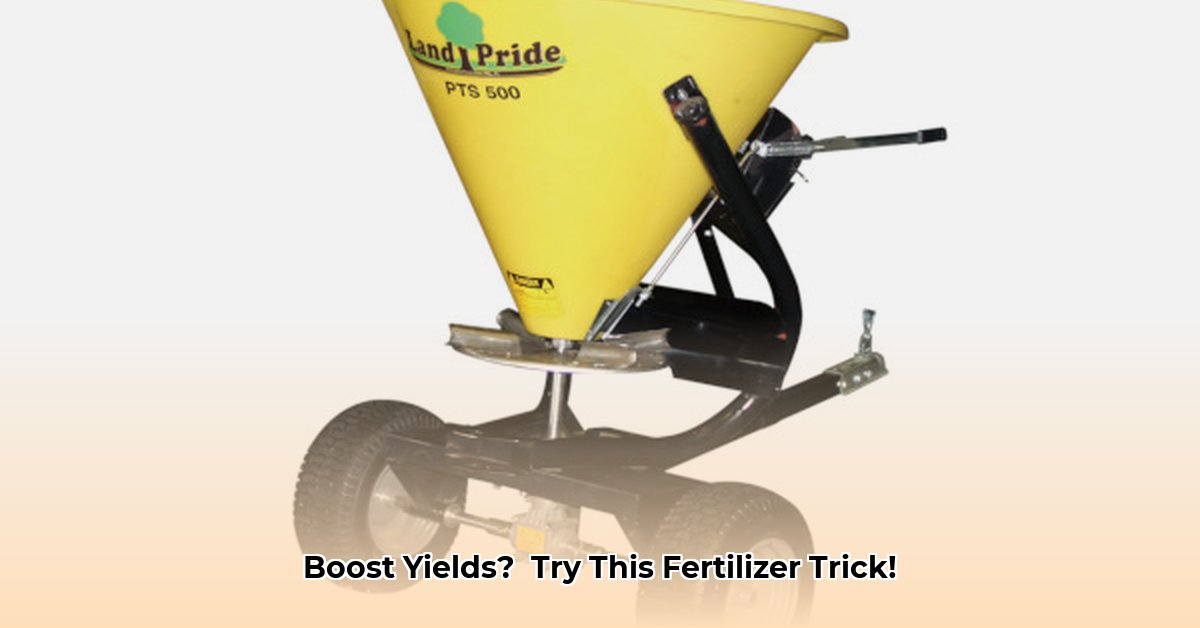
Choosing the right pull-behind fertilizer spreader and using it effectively can dramatically improve your crop yields. This guide will equip you with the knowledge to select the ideal spreader from Tractor Supply and master its use, ensuring maximum efficiency and minimal waste. For more Tractor Supply attachments, check out this helpful resource.
Choosing the Right Spreader: A Tailored Approach
Selecting the perfect pull-behind fertilizer spreader from Tractor Supply depends on several key factors. Consider these before making your purchase:
Tractor Compatibility: Ensure your tractor has sufficient horsepower to handle the spreader's weight and workload. Consult the spreader's specifications for the recommended horsepower rating. Overloading your tractor can lead to damage and inefficiency. Don't hesitate to choose a more powerful tractor if possible for added safety and performance.
Spreading Width: Match the spreader's width to your field size. Wider spreaders are faster for large fields, while narrower spreaders are more maneuverable in smaller spaces and around obstacles. Consider what type of field you will mainly be working with.
Hopper Capacity: Larger hoppers mean fewer refills, saving you valuable time and effort. The optimal hopper capacity depends on your field size and personal working habits; a larger capacity will typically increase efficiency on larger plots of land.
Spreading Method: Broadcast spreaders distribute fertilizer evenly over a wide area, excellent for large, open fields. Drop spreaders apply fertilizer in a concentrated band, ideal for row crops or scenarios requiring precise placement.
The table below summarizes these key differences:
| Feature | Broadcast Spreader | Drop Spreader |
|---|---|---|
| Spreading Method | Even coverage across a wide area | Concentrated band along a specific line |
| Best For | Large fields, uniform fertilization | Row crops, precise application needed |
| Efficiency | High, covers large areas rapidly | Moderate, ideal for precise placement |
| Precision | Less precise, suitable for even coverage | More precise, minimizes fertilizer waste |
Getting Started: A Step-by-Step Calibration Guide
Proper calibration is essential for efficient and effective fertilizer application. Incorrect settings can waste fertilizer or lead to uneven distribution, negatively impacting crop yields. Follow these steps:
Consult the Manual: Each spreader model has unique operating instructions. Read the manual carefully before beginning. It's the best guide for your specific equipment.
Accurate Measurement: Use a calibrated scale to measure the fertilizer precisely. Small inaccuracies can accumulate across a large field, resulting in major differences in fertilizer distribution.
Adjust the Settings: The manual will guide you through adjusting settings such as the rate dial (controls fertilizer dispensed), gate openings (influence flow), and spinner speed (for consistent spreading).
Trial Run: Conduct a test run in a small, inconspicuous area before fertilizing the entire field. Evaluate the distribution for evenness and adjust settings as needed for optimal results. This initial test provides valuable feedback and prevents large-scale mistakes.
Spreading with Precision: Techniques for Optimal Fertilization
With your spreader calibrated and ready, follow these best practices during fertilization:
Consistent Speed: Maintain a steady speed to ensure even fertilizer distribution. Erratic driving can lead to inconsistencies and waste.
Overlap Passes: Slightly overlap your passes to ensure complete coverage and avoid gaps. Aim for a slight overlap to guarantee that the entire field receives the correct amount of fertilizer.
Weather Awareness: Wind can significantly affect fertilizer distribution. Strong winds may require adjusting settings to prevent drift. Carefully check weather forecasts before operating and adjust accordingly. Wind is a key factor in fertilizer distribution success.
Routine Maintenance: Regular cleaning and lubrication will prolong your spreader's lifespan and ensure its smooth operation. Regular maintenance helps prevent breakdowns while ensuring longer-lasting equipment.
Long-Term Considerations: Weighing the Pros and Cons
Pull-behind spreaders offer numerous advantages but also have some drawbacks to consider:
Advantages:
- Increased Efficiency: Significantly faster than manual spreading, saving time and labor.
- Uniform Application: Provides consistent distribution, ensuring even nutrient uptake by plants.
- Cost Savings: The time and labor saved often make it a cost-effective investment in the long run.
Disadvantages:
- Initial Cost: The initial purchase price can be substantial, depending on the model.
- Maintenance Requirements: Requires regular maintenance and occasional repairs.
- Calibration Learning Curve: Mastering proper calibration takes practice and attention to detail.
By carefully considering these factors, selecting the appropriate spreader, and following the guidelines in this guide, you'll significantly enhance your fertilizing efficiency and improve crop yields. Remember, a little planning and precise execution can greatly impact your farm's overall success!